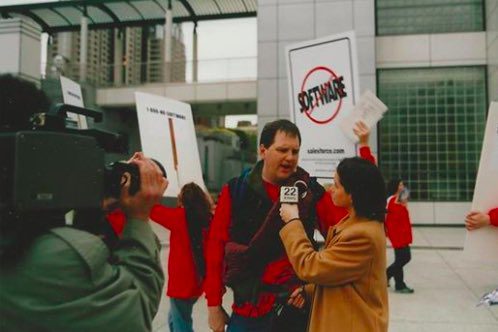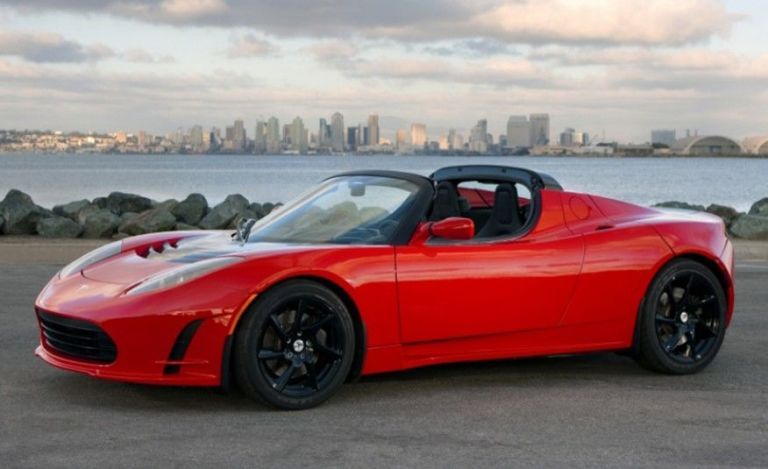In 2000, Marc Benioff decided to declare war.
He founded Salesforce a year earlier and entered the competitive CRM market.
And Siebel Systems was the market leader with a 45% market share.
So Salesforce desperately needed to get known.
Benioff worked with an agency to come up with a bold campaign.
You know what was the big idea?
At the time, all software was on-premise.
So IT teams had to install them on their servers.
But Salesforce was aiming to change that.
It was in the cloud.
Nobody had to install anything.
You could just go on a website and start using it — like we do today with any application.
Benioff decided to use this as the main point of the campaign.
The on-premise software was going to die.
The cloud was the future.
And Salesforce was going to lead the war as the challenger.
They called the campaign “The end of software.”
But one move they made was even bolder than the idea behind it.
Benioff hired actors as protesters and sent them to Siebel’s big annual conference’s parking lot.
They held “Death to software” and “The cloud must go on” signs and shouted slogans.
And of course, it grabbed the media’s attention.
They talked about it everywhere.
And it became free advertising for Benioff’s upcoming startup.

Many people remember that campaign as the most important action that made Salesforce what it is today.
And don’t get me wrong.
It was important.
But they forget another smart move Benioff made.
Benioff declared war on all CRM tools to get attention.
But he didn’t go after all customers of Siebel, Oracle, and SAP behind the scenes.
Salesforce focused its sales effort only on the sales teams of mid-size, tech-savvy companies.
Why?
Benioff thought these companies would be the most open to giving Salesforce a try.
They had relatively big sales operations.
But they still couldn’t afford big investments for on-premise CRMs.
So they’d be willing to take a risk with Salesforce’s cloud CRM — unlike timid enterprises.
And Benioff was right.
They did give Salesforce a try.
And they liked it.
Focusing only on this segment gave Salesforce two big advantages:
First, Benioff’s team quickly understood their needs.
That made Salesforce the perfect CRM for sales teams of mid-size companies.
And second, Salesforce became viral.
Salespeople told it to their friends from other companies.
And they asked for Salesforce when they switched to another company.
So Salesforce became the dominant tool in that segment in a few years.

What did Benioff do next?
Only after conquering the first pond, he jumped to the next one: enterprises.
But now things were easier.
Salesforce was already a known tool with useful features.
Plus cloud was becoming the norm unlike a few years before.
So risk-averse enterprise IT teams didn’t resist.
Salesforce also dominated the enterprise segment and became the leader CRM tool.
Benioff didn’t stop there.
Now that Salesforce was the default tool for all sales teams, it was time to go horizontal.
So he created Salesforce Service Cloud as a ticket management tool for customer service teams.
New segment, same scenario.
He kept going one by one.
Then came the Marketing Cloud for marketing teams, and E-commerce Cloud for online sales teams…
Each new addition turned the Salesforce flywheel faster thanks to competitive advantages the company built over time — like distribution and high switching costs for customers.
And that’s how a startup that hired 20 actors to protest in a parking lot became a $250+ billion company.
Dropping the bowling pins one by one
Here’s the thing.
If Benioff had not focused on a specific (and carefully selected) segment early on, Salesforce could’ve died in the Dotcom bust like many others.
But he had the right strategy.
He chose a small segment he could dominate first.
And he focused his limited resources on that target (remember Blitzkrieg).
He didn’t try to hunt in a big ocean.
He chose a small pond where he could eat all the other fish.
And he did it.
He jumped to a bigger pond only after that.
And he repeated this until Salesforce became one of the biggest SaaS companies in the world.
Geoffrey Moore calls this The Bowling Alley Strategy in his book Crossing the Chasm.
You carefully choose the first pin to hit based on your strengths and the needs of those customers.
This segment becomes your entry point into the market.
You learn their needs, you make the best product/service for them, and you become known.
You jump to the next one only after dropping that first pin.
And everything becomes easier.
You repeat it one by one by either adding new target segments to your existing offer or new offers to your existing target segment.

Three key points to use the Bowling Alley Strategy:
1. Choose the first pin carefully
The most important step of this strategy is obvious.
Choosing the right first pin to hit.
Another company that did this right early on was Tesla.
Musk knew the big money in the automotive sector was in selling to the masses.
But he also knew Tesla’s limitations as a new car maker.
Think about this.
The year is 2008.
You can make a car that can go only 244 miles with one charge.
And there are not many charging stations in the country.
Plus, your production capabilities are so low that you can only produce a limited amount of cars at a high cost.
So what segment can you dominate with this car?
Not many.
But there is one segment that you’d have a better chance.
Luxury car buyers who are early tech adopters.
They have money.
They live in specific areas.
And they are more likely to drive for joy rather than work.
So Musk carefully chose this first bowling pin to target.
And Tesla’s first model became an expensive sports car Roadster.
That’s how Tesla made a name in the niche luxury electric car category.

Roadster made Tesla known.
And it allowed Tesla to improve its technology and production capabilities.
Tesla has produced a cheaper and better car with each model since then.
Today they are closer to a mass-market model for everyone.
The moral of Tesla’s story?
Bowling Alley Strategy (like any solid strategy) requires you to know your strengths and weaknesses first.
And then finding the right bowling pin to target.
Because when that’s wrong, nothing else matters.
Use these three questions to find your ideal first segment to target:
- “What segment fits our strengths and weaknesses?”
- “What segment is small enough to dominate and big enough to matter?”
- “What segment is overlooked by bigger competitors?”
2. Find the most valuable segment
You don’t need to be a new business to use the Bowling Alley strategy.
Many founders and executives believe they are well-positioned and have a specific target segment.
But it’s rarely the case.
You can usually get much tighter with your positioning.
How?
By looking at the existing customers and data.
Some customers love your product or service more than others.
They pay more.
They complain less.
And they even bring in referrals.
So a set of customers can be 10x profitable than others.
What if you find a pattern among them and only focus on that segment?
The same scenario will play out.
You’ll better understand their needs, you’ll make the product/service better for them, and you’ll be able to talk to them with your marketing.
So you’ll have a much better chance of dominating the market.
While your competitors are busy optimizing for a few percent improvements in their marketing funnels, find your ideal positioning first.
Why chase 10% if a better positioning can bring you 10x?
3. Keep an eye on the brand
Bowling Alley Strategy also brings a risk.
It’s brand dilution.
Each line extension increases the risk of confusing customers about what the brand stands for.
And that leaves you weak against the new challengers that are simpler.
We talked about why simple brands win.
Salesforce has an e-commerce solution.
But Shopify is a $100b company on its own by doing only that thing.
So pay attention to your brand if you use the Bowling Alley Strategy.
You’ll have to redefine the brand along the way.
And sometimes you’ll have to create new brands to target a new segment.
Like Inditex’s Zara, Bershka, and Pull&Bear.
Or Accor’s Fairmont, Swissotel, and Ibis.
Because you can only extend one brand up to a point.
“The best CRM for enterprise sales teams” is clear and strong.
But “the best tool for everything” is not.
Specialists always win.
–
Enjoyed this article?
Then you’ll love the How Brands Win Newsletter.
Get the “7 Positioning Sins That Cost B2B Brands Millions” guide when you join. It’s free.
